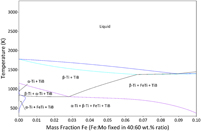Article contents
Material design and processing of a new class of titanium boride cermets with tough metallic phases and mechanical properties
Published online by Cambridge University Press: 26 October 2018
Abstract

The design and the processing of a new class of titanium boride (TiB)-based bulk cermets containing a metallic phase (β-Ti phase) for toughening is presented. The general approach is rapid reaction and densification, using starting powders of Ti, TiB2, Fe, and Mo, by electric-field-activated sintering. The cermets consist of two-phase microstructures in which the boride phase formed as a networked structure of TiB whiskers that were created in situ upon the reaction between the powders. Hardness, flexural strength, and fracture toughness measurements of these materials revealed that they possess an interesting set of properties up to: hardness values of 1090 kg/mm2, flexural strength values of 953 MPa, and fracture toughness values of 18 MPa m1/2. A remarkable finding is that although the metallic phase fractured by microscopic cleavage, the cermets showed good fracture toughness values. The present study not only illustrates the process details and microstructure leading to these properties but also provides a broad powder metallurgical approach to design and synthesize cermets that may yield further improved properties.
- Type
- Article
- Information
- Copyright
- Copyright © Materials Research Society 2018
References
REFERENCES
- 10
- Cited by


